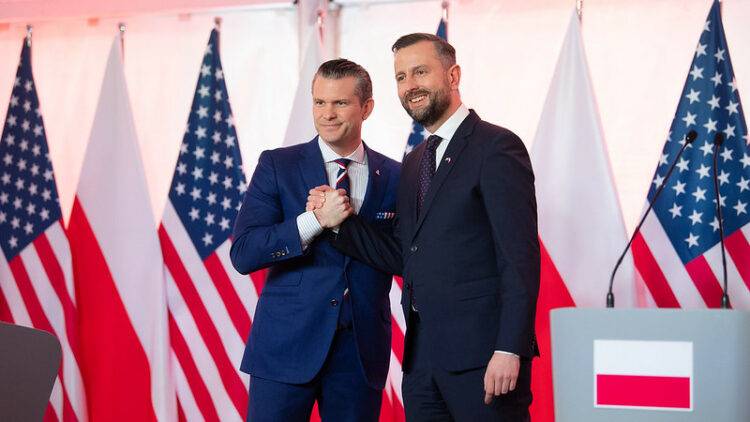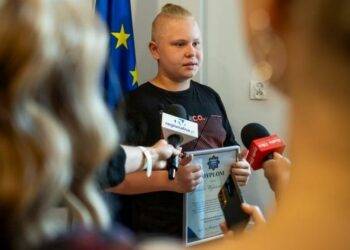Poland’s commitment to defense spending should serve as a model for NATO allies, U.S. Secretary of Defense Pete Hegseth said during a press conference in Warsaw on Friday. Meeting with Polish Defense Minister Władysław Kosiniak-Kamysz, Hegseth emphasized that other NATO nations must increase their military budgets to enhance collective security.
“Our first trip is to Poland; the symbolism is not lost. Poland is a model NATO member,” Hegseth said. “Hard power is the most important, and Poland understands that perfectly. Peace through strength. Two percent is not enough.”
“Poland is investing not only in its own defense but in the defense of the entire European continent,” Hegseth said. He underscored the importance of military preparedness, stating that while diplomacy plays a role, in the end, “ammunition, tanks, and helicopters, along with hard power, will count.”
Hegseth echoed former President Donald Trump’s call for NATO members to raise their defense spending from the current 2% minimum to at least 5% of GDP. Poland, one of the highest defense spenders in the alliance, is set to allocate 4% of its GDP to defense in 2024, with a planned increase to 5% in 2025. Much of this funding is directed toward procuring U.S.-made weaponry.
Kosiniak-Kamysz underscored Poland’s historical perspective on security, stating, “We have a long memory of the importance of security, peace, and freedom. Strength doesn’t come without spending.” He called on European allies to take greater responsibility for regional defense, stressing, “Europe must pay its share. Europe must wake up. We want a joint venture between Poland and the U.S.”
Poland’s Military Spending Stands Out
Poland currently allocates nearly 5% of its gross domestic product (GDP) to defense, significantly surpassing NATO’s 2% minimum requirement. The country has prioritized military expansion, citing security concerns due to its proximity to Russia and Belarus.
While Poland bolsters its defense, many NATO countries struggle to meet even the existing 2% target. The U.S. has repeatedly pushed for increased spending across the alliance, with Hegseth reinforcing that message. “Other NATO members must step up their contributions,” he said.
Poland’s defense strategy is shaped by historical threats from Russia, particularly in the wake of Moscow’s 2022 invasion of Ukraine. The country has been a strong supporter of Kyiv, serving as a key hub for military aid deliveries and training efforts.
Shifting U.S. Approach to Ukraine
Hegseth also reaffirmed a shift in U.S. policy regarding military support for Ukraine, emphasizing that any potential troop deployments to Ukraine should not fall under NATO’s collective defense obligations.
“To be clear, U.S. troops will not be deployed in Ukraine as part of any security guarantee,” he said, suggesting that if any peacekeeping forces were to be sent, it should be outside NATO’s jurisdiction. He stressed that European nations must take the lead in providing Ukraine with military and humanitarian aid.
Poland has been a key supporter of Ukraine since Russia’s full-scale invasion in February 2022. However, Washington’s recalibrated stance places greater responsibility on Europe. This realignment has prompted concern among some European leaders, who continue to advocate for unified Western backing of Kyiv.
“I call on all political forces and leaders to suspend disputes about war and peace in Ukraine and unite in the face of threats from the East,” Polish Prime Minister Donald Tusk said Thursday. “Poland, Europe, and the entire West need full cooperation and solidarity today.”
Growing European Responsibility in Security
The foreign ministers of the Weimar Triangle—Poland, Germany, and France—alongside officials from Italy, the UK, and Spain, released a joint statement stressing that Europe must take an active role in negotiations concerning Ukraine’s future. European Union foreign policy chief Kaja Kallas echoed this sentiment, arguing that the EU should be at the forefront of discussions to resolve the conflict.
The shift in U.S. policy has raised alarms in Warsaw. Polish Foreign Minister Radosław Sikorski recently warned that failure by the U.S. Congress to approve a proposed $60 billion aid package for Ukraine could have “profound consequences” for U.S. allies worldwide.
“Some countries will start hedging their bets, and others will consider developing their own nuclear weapons programs,” Sikorski said. He also criticized Trump’s controversial remarks suggesting he would encourage Russia to attack NATO members failing to meet their defense commitments.
“Poland sent a brigade to Ghazni, a tough province in Afghanistan—and we didn’t send an invoice to Washington,” Sikorski added. “A military alliance is not a neighborhood security company.”
Poland’s Role in U.S. Defense Strategy
Despite uncertainties surrounding future U.S. military aid to Ukraine, Poland remains one of Washington’s closest security partners in Europe. U.S. arms sales surged to $238 billion in 2023, with Poland among the primary buyers. The country has significantly increased its military procurement, with the share of its defense budget dedicated to acquisitions rising from 20.4% in 2022 to 35.9% in 2023.
Poland has also long advocated for a greater U.S. military presence in Central and Eastern Europe, citing concerns over Russian aggression. While NATO remains committed to defending its members, the latest statements from Hegseth suggest a growing expectation for European allies to shoulder more of the security burden.
As geopolitical tensions persist, Poland’s military investments and calls for a stronger European role in security may shape the alliance’s future defense posture.


















